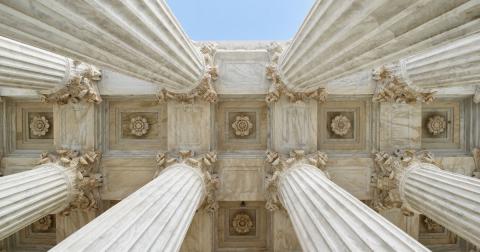The Supreme Court holds one of the most delicate roles in our republic. This is not only because of judicial review, which gives that branch virtually unlimited power to dictate both changes as well as continuity in our nation’s development. It is also because court must perpetuate the public’s perception that they are the most impartial branch of government, in order to retain their stature and legitimacy.
That perception is at least in part deceiving. As Rachel Sheldon explains, the public perception of the court as a nonpartisan body was only created during the past century. Perfection is unattainable in such a context, as the Supreme Court often deals with fundamentally partisan issues. Yet, they arguably remain the most respected branch for good reason.
Chief Justice John Roberts is apparently cognizant of one of the larger challenges in the abortion cases that have recently come before the court. However, Robert’s concern may be overstated in this regard.
While the Framers understood this would be one of the roles of the court’s, judicial review is a precedent. In Whole Woman’s Health v Austin Reeve Jackson, Roberts notes that “it is emphatically the province and duty of the judicial department to say what the law is.” This precedent to which Roberts is referring, the 1803 Marbury v Madison decision, established the court’s right to have the last word on whether a law is Constitutional or not. Precedents are powerful and resilient, but certainly may be challenged. This is the Chief Justice’s concern. “The clear purpose and actual effect of S.B. 8 has been to nullify this Court’s ruling,” Roberts argues in his recent partial dissent. Roberts is alluding to the prior rulings, such as Roe v. Wade in 1973 and Planned Parenthood of Southeastern PA. v Casey in 1992, which the Texas law is attempting to maneuver around.
Yet, even if the Supreme Court ultimately overturns the precedent they set, it would still be the court’s prerogative to do so. Judicial review is not what is truly at stake here. The court’s contemporary credibility as the least partisan institution is what is at the true heart of the matter. In other words, their legitimacy is derived from the people’s acceptance of their rulings, as Justice Stephen Breyer discussed during a recent speech that expanded on this very subject. That remains contingent on how impartial they are perceived to be.
The justices must and often do walk a fine line between the question of what the constitution says and how their own political ideology dictates their interpretation of that sacred document on issues with no clear answer.
This does not mean that all decisions put forth by the Supreme Court have been partisan or written with a political agenda, obviously. For example, unanimous decisions have been common from over the past decade, according to Louis Jacobson.
As stipulated by the Constitution, justices are not elected. This is to promote impartiality. The Founders spoke of their independence in depth. “This independence of the judges is equally requisite to guard the Constitution and the rights of individuals,” according to Alexander Hamilton in Federalist Paper number seventy-eight. However, one should not discount that they are nominated and confirmed by political entities. There is a political reason a particular individual is nominated by a particular president. Supreme Court Justices are also human. Therefore, the lens through which an individual justice reads the Constitution, especially in challenging cases, is inherently swayed by the progressive or conservative ideology to which they subscribe.
This is why new precedent setting decisions of the past have employed text of the Constitution that was present long before the decision itself. In such cases it was not the text that changed, but rather the ideology of those interpreting it that did. Quite often this has advanced the admirable ideals that are part of America’s identity. One could point to examples such as Brown v Board of Education in 1954 and Obergefell v Hodges in 2015 to illustrate such positive advances in our society.
Partisan issues and agendas are not limited to one or two branches. They are fundamentally present in all three. For better or worse, our republic is inherently political. Consequently, what is at stake in the Supreme Court today is not proving that the court is devoid of political ideologies. Instead, the court is tasked with proving they are the least partisan among the three branches.
